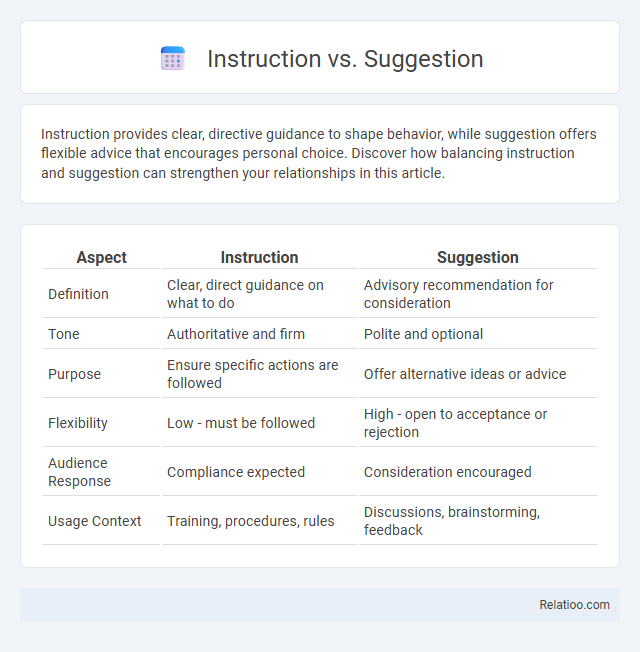Instruction provides clear, directive guidance to shape behavior, while suggestion offers flexible advice that encourages personal choice. Discover how balancing instruction and suggestion can strengthen your relationships in this article.
Table of Comparison
| Aspect | Instruction | Suggestion |
|---|---|---|
| Definition | Clear, direct guidance on what to do | Advisory recommendation for consideration |
| Tone | Authoritative and firm | Polite and optional |
| Purpose | Ensure specific actions are followed | Offer alternative ideas or advice |
| Flexibility | Low - must be followed | High - open to acceptance or rejection |
| Audience Response | Compliance expected | Consideration encouraged |
| Usage Context | Training, procedures, rules | Discussions, brainstorming, feedback |
Understanding Instructions and Suggestions
Understanding instructions requires clear, explicit directives that specify exact actions and expected outcomes, ensuring compliance and precision. Suggestions offer flexible guidance, promoting autonomy by encouraging individuals to consider alternative approaches without rigid enforcement. Distinguishing between instructions and suggestions enhances communication effectiveness by aligning expectations and fostering appropriate responses in various contexts.
Key Differences Between Instructions and Suggestions
Instructions provide clear, authoritative commands that require specific actions, while suggestions offer flexible advice or recommendations without strict requirements. Instructions are typically detailed, outlining precise steps to achieve a particular outcome, whereas suggestions encourage consideration of options to enhance decision-making. Your choice depends on whether you need firm guidance or supportive input tailored to your context.
Importance of Clarity in Communication
Clear communication differentiates instructions from suggestions and advice, ensuring your message is understood as intended. Instructions provide explicit, actionable steps, while suggestions offer flexible options and advice implies informed recommendations. Prioritizing clarity helps prevent misunderstandings, making your communication efficient and effective.
When to Use Instructions
Instructions are necessary when precise, step-by-step guidance is required to complete a task accurately, ensuring safety or compliance with standards. Suggestions are appropriate for offering flexible advice or optional ideas without enforcing a specific course of action. Use instructions in situations demanding clarity and accountability, such as operating machinery, following legal procedures, or adhering to technical specifications.
When to Offer Suggestions
Offering suggestions is most effective when you want to encourage collaboration and provide options without limiting your audience's autonomy, especially in situations where you seek input or creativity. Use instructions when clear, specific actions are necessary to achieve a particular outcome, ensuring precision and compliance. Your approach to guidance should depend on the context, balancing clarity with flexibility to foster better decision-making and engagement.
Benefits of Providing Suggestions
Providing suggestions enhances your decision-making by offering flexible options tailored to specific needs, fostering creativity and problem-solving. Unlike rigid instructions, suggestions empower individuals to evaluate alternatives and select the most suitable approach, improving adaptability. This collaborative approach boosts engagement and encourages proactive involvement in achieving goals.
Risks of Misinterpreting Instructions
Misinterpreting instructions can lead to serious safety hazards, operational errors, and inefficient task execution, especially in high-stakes environments like healthcare or aviation. Instructions are explicit directives requiring precise compliance, while suggestions offer flexible guidance, making their distinction crucial to prevent confusion. Clear differentiation reduces risks of ignoring critical steps or misapplying advice, ensuring proper implementation and minimizing potential negative outcomes.
Effective Ways to Deliver Instructions
Effective ways to deliver instructions include using clear and concise language tailored to the audience's level of understanding, incorporating visual aids such as diagrams or videos to enhance comprehension, and providing step-by-step guidance that allows for easy follow-through. Emphasizing key points through repetition and seeking feedback ensures that instructions are correctly interpreted and executed. Encouraging active participation and clarifying any ambiguities increases the likelihood of successful task completion.
How to Phrase Helpful Suggestions
When phrasing helpful suggestions, use clear, positive language that respects Your autonomy and encourages collaboration. Frame your advice as potential options instead of commands to promote open-mindedness and reduce resistance. Emphasize benefits and offer actionable steps, ensuring your suggestions are easy to understand and implement.
Choosing the Right Approach: Instruction or Suggestion
Choosing the right approach between instruction and suggestion depends on the context and your goals for influencing behavior or decision-making. Instructions provide clear, direct guidance that ensures compliance and consistency, ideal when precise outcomes or safety are priorities. Suggestions offer flexibility and encourage autonomy, making them more effective when fostering creativity, engagement, or collaborative problem-solving in your team.

Infographic: Instruction vs Suggestion
 relatioo.com
relatioo.com